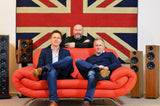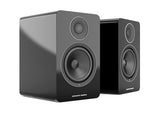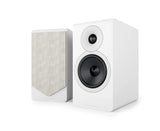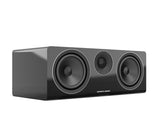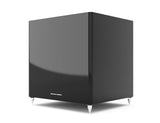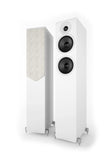Opera Loudspeakers - Opera Prima Bookshelf/Stand Mount Speaker
Opera Loudspeakers

The Company

Opera Loudspeakers was founded in 1989, but its origins go back to the early 1980s, to an unusual but highly fruitful synergy between two cultures and two audiophiles, one Italian and the other English. The first loudspeaker to bear the Opera name was called Caruso, and was the precursor of a series named in homage to the legendary voices of the lyric opera. Callas, Operetta and Divina soon followed, each gaining enthusiastic acclaim in the developed audio markets of the world. Opera loudspeakers immediately appeared as a fusion between the old and the new: between traditional Italian craftsmanship in cabinet-making and the most advanced acoustic technology. Every Opera loudspeaker, even the least expensive model, follows a tried and tested philosophy of design: the use of top quality materials allied to carefully applied basic principles of acoustic science. Today our loudspeakers are exported everywhere, from Europe to the Far East with relevant space on the most important hi-fi magazines.
Our intent is to create a complete line of high quality , beautiful to see and to listen to; we then developed over therefore also a line of accessories with the same principle that gave prestige to our speakers.
Gianni Maria Sacchetti, founder
Opera Loudspeakers - Opera Prima v.2 Bookshelf/Stand Mount Speaker Pair
The introduction to this loudspeaker starts with a very simple observation: we have studied the acoustics of confined spaces with the utmost care and then... we forgot about it in the creation of loudspeaker cabinets, which is still a confined space, even if it is small compared to a living space.
The cabinet
The result that has emerged over the years is a progressive increase in decay times inside the cabinet, with localised resonances being emitted outside by the loudspeaker membrane itself. For this reason, we have changed the ratio of the cabinet dimensions, reducing the resonances and diluting the normal modes over a larger frequency range, thus drastically decreasing their amplitude.
Once the dimensions of the cabinet had been optimised, we used a polyurethane material with a much higher density for the internal absorber than previously used. The result obtained by the measuring probe positioned inside the cabinet was that all internal resonances were reduced by at least an order of magnitude, with the ineliminable low-medium frequency resonances decaying in an extremely short time.
When listening, there is a superior rendering of detail and performance at the lowest listening levels, minimums that contribute greatly to the performance and ambience reconstruction of the recording. Two particular measurements, developed in-house both as software and hardware, allowed us to precisely quantify this improvement throughout the reasonably useful range, that is, from the mid-low to the high range. Once the dimensions were established, we measured the changes in acceleration of the side walls, obtaining, among other things, the pressure emitted by these, pressure that would otherwise not be measurable.
The action at the points of greatest stress has been further reduced with much smaller internal reinforcements than in the past, avoiding additional colouring, which is often a far worse cure than the illness to be cured. The two walls, the upper and lower, have been made with special attention to their relative angles so as to interfere with each other as little as possible. The lower wall has also been made slightly angled.
Obviously, as is our well-established custom, we have appropriately milled the speaker passage hole internally in order to minimise the acoustic tunnel effects that would otherwise be created in the midrange. The rear connectors are designed to offer maximum versatility in cable connection.
The speakers
Contrary to what one might believe, the drivers used in the entire series of speakers in this line have not been built, as they say, to our ‘rigid specifications’. We certainly do not pretend to teach a world-renowned manufacturer like Scan Speak how to make good sounding drivers! We have merely laid the foundations that we felt were necessary in order to obtain loudspeakers that would enhance certain particularities in the reproduction of music, without penalising the measurements.
The collaboration with the technicians of the prestigious Danish brand resulted in very few prototypes until we decided to use the best performing one in our project. The ratios between the quantities that make up a loudspeaker to obtain practically identical instrumental results are many, but when listening, we have always noticed differences, sometimes considerable, in the choice of overall balance. None of the loudspeakers in this series have standard characteristics, with the masses carefully calibrated to achieve excellent surface damping and low mass due to the choice of materials. The ratio of mass to compliance has also been modified, along with the design of the magnetic complex, to achieve lightning-fast acceleration in the mid-bass and midrange.
The 18cm woofer used in this model represented a remarkable and constructive collaboration with Scan Speak. It was carefully screened mainly in the listening room, before being measured and technically verified. To an extremely generous excursion it adds a remarkable dynamic linearity thanks to the special design of the polar terminations and the considerable force factor. The horizontal dispersion has been carefully evaluated on the basis of in-room listening and the design of the recreated scene, an absolute priority for us. The load chosen is a bass reflex, optimised to obtain a well-damped performance and a reasonable extension without the listening should suffer in terms of performance and continuity of the harmonics of natural instruments.
The chosen tweeter presents slight variations from the model proposed to us by the Danish manufacturer in the choice of materials inside the chamber behind the dome, which is strictly soft and damped.
The crossover filter
There is a considerable difference between the electrical order of a filter and the order that the loudspeaker takes on when adding the electrical response to the acoustic response. We, under normal conditions, listen to the acoustic pattern and it is only to this that we need to pay attention. Despite the aluminium diaphragm, there is no resonant cell on the low-pass of the woofer, whose damping is only regulated by the ratio of inductance to capacitor, thus also being able to vary the acoustic phase pattern at the crossover.
The apparent simplicity of this low pass lies in the work done upstream about the absence of colouration and resonances. The high-pass for the tweeter must ensure sufficient thermal stability for its voice coil and has to deal with listening performance even when the volume is very high. An in-house study allowed us to establish a correct procedure for defining the minimum crossover frequency before even the slightest change in timbre was noticeable at high levels. The high pass not only regulates the levels of timbre continuity between woofer and tweeter, but also carefully adjusts the damping of the response and consequently the acoustic phase of the transducer in the vicinity of the crossover frequency.Decisive was the choice of filter components, which were carefully evaluated when listening. The use of Vishay resistors and Mundorf capacitors on the signal and ground paths allowed us to enhance the already remarkable characteristics of transparency in listening and is unmatched in loudspeakers in this price range. The inductances were made to our insistent specification of shape, size and gluing of the coils. The result obtained when listening to them proved the correctness of our choices by providing an otherwise unattainable performance.
The PCB is made to our own design, with a layout and positioning of the components that does not alter in any way the response initially detected on the prototypes and used as feedback and verification. Finally, the wiring between the crossover and the two transducers has been carried out with cable of considerable cross-section, using copper of excellent purity.
Instrumental results
The instrumental performance, placed slightly in the background compared to the listening performance, confirmed both the remarkable construction characteristics in terms of cleanliness and linearity and the goodness of the choices made in the design.
The speaker's average sensitivity is 90 dB, measured with 2.83 vrms at the terminals, with the microphone positioned one metre away. The low range response appears well damped and devoid of any emphasis, according to the desired tuning conditions. The chosen crossover frequency, about 2500 Hz, does not present any particularities in off-axis measurements, maintaining a trend of the two acoustic phases practically equal to the trend on the axis. The impedance module does not drop below 3.8 ohms, maintaining a phase trend that at most drops to -45° so that the nominal load of 6 ohms is also sustainable by valve amplifiers.
Distortion appears low and shows no particular variations as the input level increases. Our particular measurement of articulation shows no particular variations between 85 and 95 dB average pressure. Thanks to these characteristics, we can say with some pride that the timbre of the loudspeaker and its characteristics of soundstage and articulation change very little as the input power increases, even noticeably.
Technical specification
|
|
Prima V2 |
|
Type |
Two-way |
|
Bass-Reflex |
|
|
Bookshelf |
|
|
|
Speaker |
|
Drivers |
Tw |
|
Mid/Woofer |
|
|
|
|
|
|
|
|
Sensitivity (2.83V/1m) |
90 dB |
|
Frequency response (-3 dB) |
50Hz - 21000kHz |
|
Nominal impedance |
6 Ohms |
|
Minimun impedance |
3.8 Ohms |
|
Maximun power: |
100W without clipping |
|
Recommanded amplifier power |
25-100 W |
|
Crossover frequenciency |
2500 Hz |
|
Dimension |
Cabinet only: 237x428x390mm (lxhxd) |
|
Complete loudspeaker (with stand): 312x1162x449mm (lxhxd) Stands Not Included |
|
|
Net Weight |
14 Kg |








